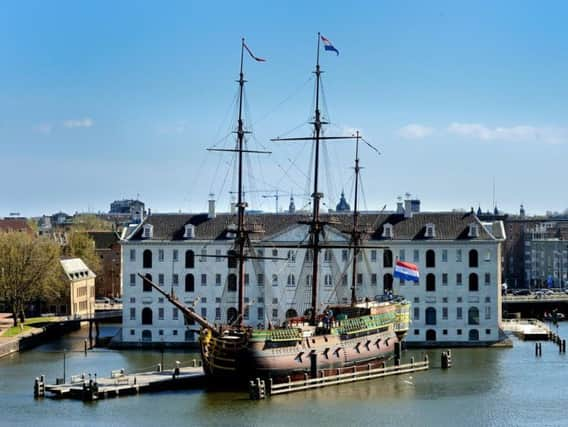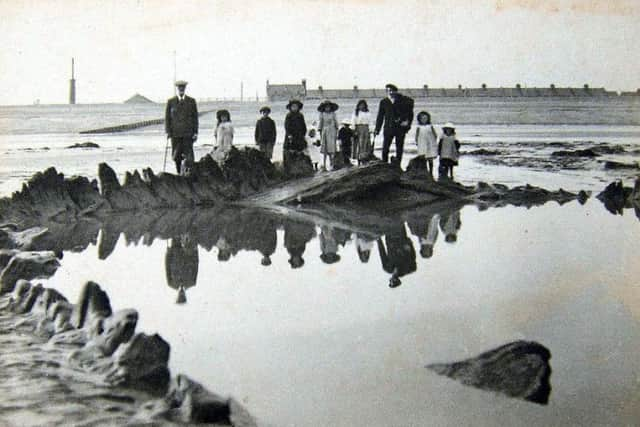Ill-fated Dutch East Indiaman fetched up on Sussex shore


Here I continue with the fate of the “Anne”. The damaged and burning warship came aground at Pett Level Beach. It settled on the seabed a short distance offshore. Little was left after the combined effects of fire and salt water but enough remained that down succeeding decades on occasions at low tide the outline of the “Anne” became visible. In February 2013 she emerged for the first time in 15 years; shipwreck experts found that the vessel’s hull extended down some three yards into the sand.
What’s left of the “Anne” is owned by the Warship Anne Trust. The latter is affiliated to the Hastings Shipwreck Museum and Heritage Centre where artefacts salvaged from the vessel are housed along with paintings depicting the ship in her prime.
Advertisement
Hide AdAdvertisement
Hide AdLast week I also highlighted the amusing coincidence whereby the fiery end of “HMS Anne” was due to a French Admiral called Anne-Hilarion, Comte de Tourville. An equally odd coincidence concerns Pett Level Beach where the “Anne” became grounded. The shipwright who constructed her in Chatham Dockyard was … Phineas Pett II. It’s a fact that’s totally on the level!


After the story was published I heard from reader Geoff Bridger of Ringmer: “Some years ago I met a craftsman who made ornaments from the salvaged wood of ‘HMS Anne’. Especially interesting were items purportedly made from the rudder; its wood being lignum vitae, incredibly hard and dense enough to sink in water. The man apparently had permission to use the 'uninteresting' timber and made attractive items for sale at craft fairs.
“I purchased a set of coasters and also a lamp base. Both had been attacked over the years by a type of sea worm and the resulting damage added to the attraction.”
The shore at Hastings features a second wreck, the “Amsterdam”. She lies buried in the sand at Bulverhythe and was an East Indiaman built to facilitate trade between the Netherlands and the Far East. Outward-bound East Indiamen would carry European goods along with building materials and weapons plus gold and silver coins. Crew and passengers would typically number 250 persons with many being would-be settlers. For the return sailing the cargo comprised exotic spices and preserved foodstuffs, ceramics and silk. The ship’s complement would typically number around 70.
Advertisement
Hide AdAdvertisement
Hide AdThe “Amsterdam” was built of oak in the Dutch city of the same name. Her maiden voyage should have taken her from Holland to the East Indies laden with woolen textiles, wine and other goods. Her most valuable cargo comprised 27 chests of silver guilders. The captain was Willem Klump. As well as the crew also aboard were 127 soldiers and five passengers.


The ship was ill-fated from the start. On 15th November 1748 she set sail from the Netherlands but with the wind direction unfavourable she returned to port four days later. A second attempt to get away was equally unsuccessful. Indeed, it was not until 8th January 1749 that she finally cleared the North Sea and entered the English Channel. Here she ran into a powerful storm that stalled her progress for many more days; the furthest west she tacked saw her off Beachy Head. Conditions on the “Amsterdam” were wretched and the misery of those aboard was compounded as a plague-like disease swept the ship and claimed 50 lives. Mutiny was already in the air before a further disaster struck when the ship’s rudder snapped off leaving the vessel at the mercy of strong winds and a roiling sea. On 26thJanuary she was driven ashore at Bulverhythe, three miles west of Hastings, to become embedded in the sand and mud close to the beach.
Mercifully everybody aboard got safely ashore. “Amsterdam” sunk ever-deeper into the mud, making any attempt to refloat her impossible. Much valuable cargo, including the chests of silver guilders, was recovered. Inevitably, looters came in search of easy pickings and soldiers guarding the wreck shot and killed one of them. As time went on, the ship’s superstructure gradually disappeared, leaving the hull embedded in the sand and invisible to any casual observer on the shore.
Even local people forgot it was there. Then, in 1969, an exceptionally low spring tide revealed the remains of the “Amsterdam”. Marine archaeologists were excited at the discovery and surveys were carried out that concluded that here were the remains of the world’s best-preserved Dutch East Indiaman.
Advertisement
Hide AdAdvertisement
Hide AdIn addition, large numbers of artefacts were recovered, including cannons, many of which are now exhibited in the Shipwreck collection in Hastings. The anchor of the “Amsterdam” is displayed in St. Katherine’s Dock, London, and a full-size replica of the ship is moored beside the Netherlands Maritime Museum in Amsterdam.
The original “Amsterdam” is out of bounds to the public under the 1974 Protection of Wrecks Act. However, her outline can be seen at very low tides on the beach opposite the footbridge over the railway line at Bulverhythe.
Experienced guides from the Shipwreck Museum do conduct guided tours of the remains of the “Amsterdam”. The Museum/Heritage Centre is in Rock-a-Nore Road, Hastings, East Sussex TN34 3DW. Visit: www.shipwreckmuseum.co.uk Admission is free. From now until April 2018 it is open on Saturdays and Sundays only from 11am to 4pm.